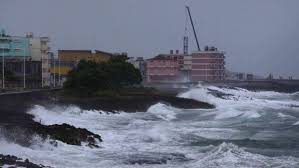Within hours, Hurricane Matthew will smash its Category 4 chaos on the narrow, flat peninsula that is the State of Florida. And here I sit, safe from this destructive powerhouse about which many in my area remain blissfully unaware; writing from my porch in tiny West Bend, WI. Despite this distance, what I know from research is that, while the evacuation of humans from the highest-risk areas may prove effective in saving lives, in every other way Florida cannot possibly be ready for this.
Category 4 is massive. It has been over 100 years since a Category 4 hurricane hit Florida.

And that was the ONLY time.
The deadliest hurricane on record happened in Galveston, TX, in 1900. That hurricane? Category 4. To add perspective, Hurricane Katrina — infamous for its horrific explosion on the City of New Orleans — was Category 3.
The only Category 5 hurricane to hit the USA was Andrew, in 1992. Fortunately for Florida, Andrew did not dump loads of rain. Why? Because the dikes holding back Lake Okeechobee can handle heavy winds and fallen trees. Excessive amounts of rainfall? Not so much.
According to Lloyds Emerging Risk Team, Southest Florida’s Lake Okeechobee – roughly the size of Rhode Island — is the second most hurricane-vulnerable place in the United States, right behind New Orleans. Eventually, the Lake’s dikes can contain only so much water.
Currently, according to Florida Fish & Wildlife Conservation Commission (FWC), Lake Okeechobee’s depth sits at near-record averages of about 15.5 feet:
“Okeechobee water levels continue at almost record highs after an extremely wet summer and fall. The current water level on Lake Okeechobee as of September 25, 2016 is 15.66 ft. NGVD, just over a foot higher than last year. The lake level has increased almost a foot within the last month.”
Hurricane Matthew will drop at least 7″ of rain into the Lake, causing a rise of perhaps 2-feet. It is possible Matthew will pour 10″ or more — and that could create as much as a 3-foot rise.
The lowest of Okeechobees dikes rests at slightly higher than 18 feet — uncomfortably low with Hurricane Matthew approaching, according John Campbell of the Army Corp of Engineers.
Parts of the Herbert Hoover Dike that surrounds Lake Okeechobee start to become vulnerable at 17.5 feet, Campbell noted.
“Certainly our concern all year is what happens if we get a lot of precipitation and the lake level rises,” Campbell said. “A (rise over 17 feet) would take us to areas where historically we’ve had some challenges and it’s certainly something we’d like to avoid.”
An unfortunate byproduct of Hurricane Matthew may be that the historic HABs (Harmful Algae Blooms) of 2016, which wiped out most of Southeast Florida’s Gold Coast tourist season, will repeat themselves in 2017. Hundreds of millions in tourist dollars will again be at stake.
For area businesses who rely on tourist trade, this loss of income would clearly be devastating.
That said, if Matthew causes a breech to a significant piece of the Lake Okeechobee dike — and this possibility is at present razor-thin close — Southeast Florida will be looking at a disaster reminiscent to what we saw in New Orleans, with Hurricane Katrina.
In two days, we’ll know.



